Reacting to the transfer of Jack Grealish to Man City, Aston Villa have reacted quickly signing Leon Bailey from Bayer Leverkusen and Danny Ings from Southampton to go alongside Emi Buendía who had already signed. For Southampton in particular, losing their best striker to a direct rival is a big blow. However, the Saints now have over 35 million euros and the opportunity to bring a younger player in.
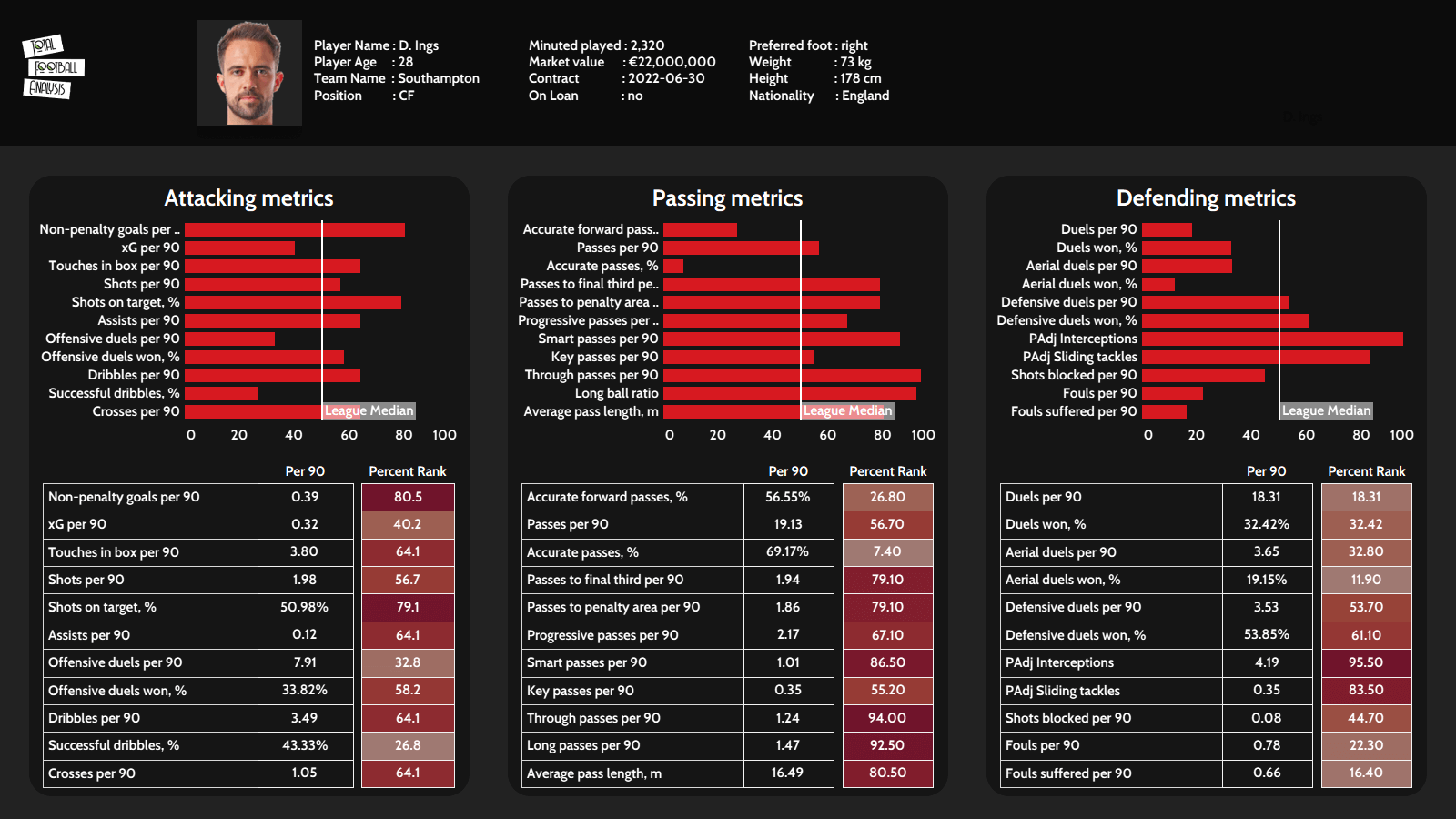
In this data analysis, we have used our exclusive xGOLD tool to find four players statistically similar to Danny Ings (data profile above) who are approaching their peak age (under 25 years old) and who wouldn’t cost too much for Southampton (valued at 10 million euros or less on transfermarkt. The analysis of the best four results follow with similar statistics to Danny Ings’ follows.
Irvin Cardona – 23, Stade Brest, Ligue 1
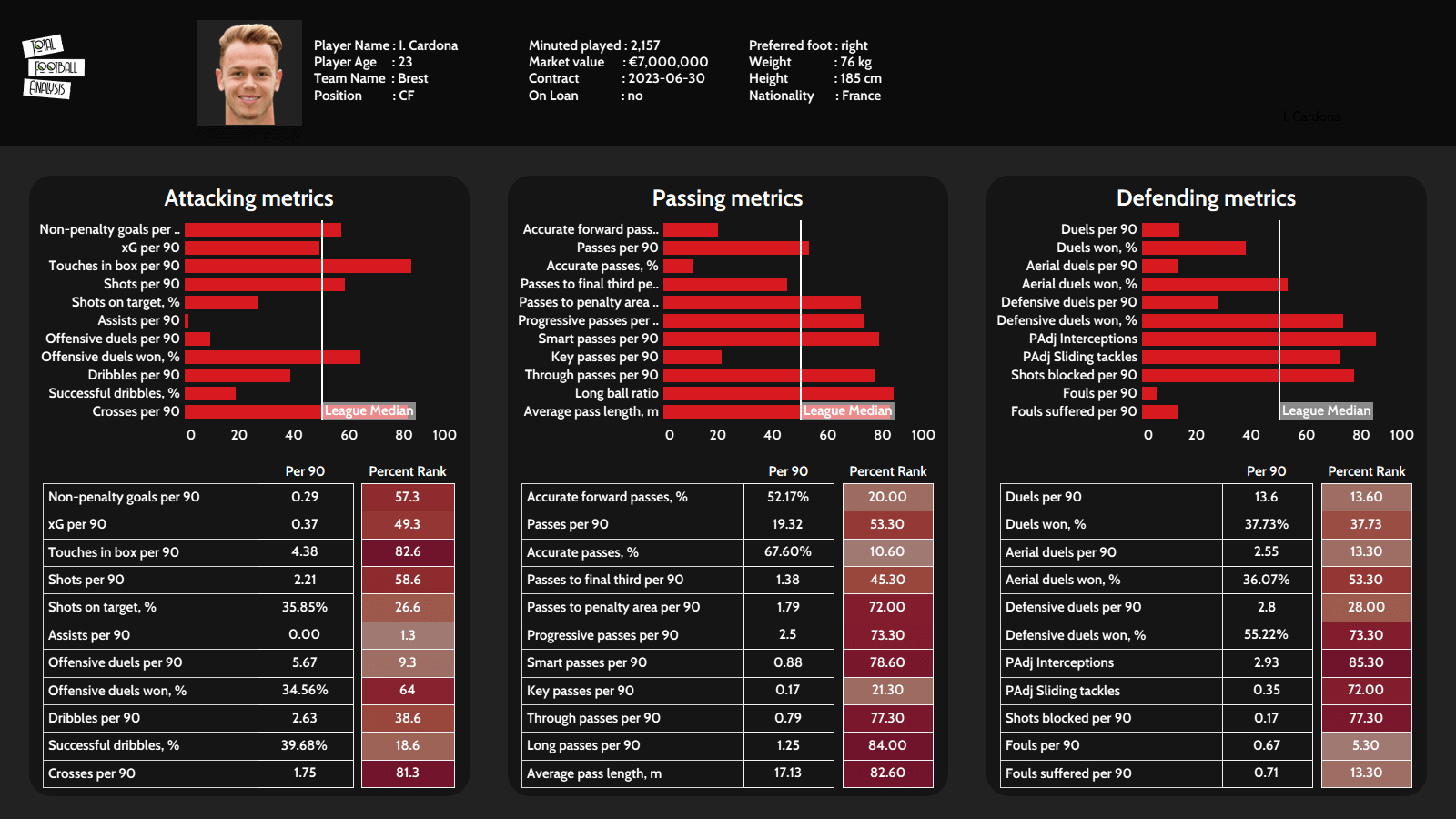
Irvin Cardona is a French striker born in 1997 who came through Monaco’s academy, where he was a hot prospect after scoring seven goals in ten games in the UEFA Youth League. However, he only played seven matches for the first team without scoring before leaving on loan to Cercle Brugge for two seasons. In Belgium, he scored 15 in 38 matches, earning a move to Stade Brest in 2019 for 1.5 million euros. Since his arrival at Brest, he has scored 15 in 61 games, eight of them last season in the Ligue 1.
Cardona has a good size standing at 185cm and is predominantly right-footed. Despite his size, he’s well-coordinated and possesses good pace over short and long distances. He combines good levels of strength with agility to turn and change directions, making him a very interesting profile from the physical point of view.
With his elegant and quick movements, Cardona can receive the ball with his back to the goal and turn quickly and in few touches and handle the ball in tight spaces. All this is possible thanks to his good technique. He uses his first touch very well and is good in quick combinations.
Being capable of using either foot comfortably and with his size and ability to play first-touch layoffs, he can be used as a target man and drift wide to help his team progress. His 1.75 crosses per 90 (81st percentile) show how much he drifts wide. Despite not attempting too many passes (just 19.32 per 90), Cardona is among the best strikers in progressive passes (2.5 per 90), through passes (0.79 per 90) and passes into the box (1.79 per 90), showing how much he can contribute in the second line too.
As the attacks advance, Cardona tends to get central and excels in his movements in and around the box. Cardona’s movements to get away from defenders are intelligent and quick in the box, changing directions, creating separation and anticipating the defenders depending on how the attack is evolving.
He plays on the shoulder of the last defender and makes elite-level runs in behind, with top timing and speed. Cardona often chooses to stay in an offside position so he can’t be marked to then make curved runs to get back into a legal position before running into space. Once in the box, he poaches goals around the six-yard box and is always ready for a tap in. In set-pieces, he does well attacking the near post and has scored some very well executed headers.
When it comes to shooting, Cardona can do it with either foot and create a yard with good feints, taking almost no time for him to shoot after a quick movement.
However, Cardona’s finishing isn’t the best. He has good ideas and also good technique but needs some fine-tuning and consistency to get the maximum out of the great chances he generates. Has had great streaks in front of goal and needs to make that the norm. With 0.29 goals from 0.37 xG per 90, he should be scoring 22% more goals.
Kevin Nisbet – 24, Hibernian, Scottish Premiership
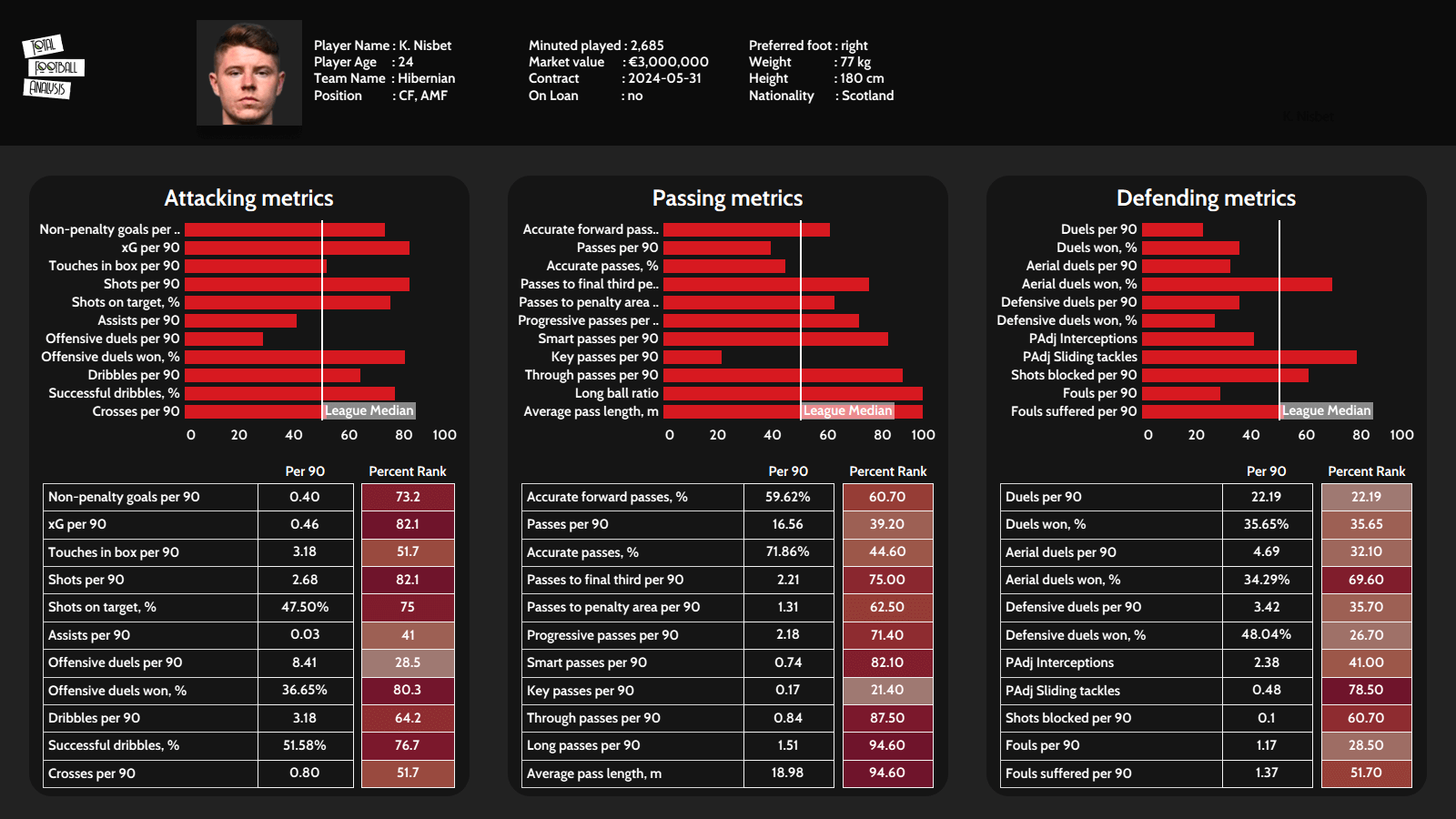
Kevin Nisbet is a Scottish striker born in 1997 who has played in the top four divisions of Scotland so far, slowly climbing through the football pyramid until getting into the Scottish Premiership with Hibernian. He has played for a total of seven clubs in his senior career. His scoring record is great at every level with three goals in three games in the Scottish League Two, 29 in 34 in the League One, 22 in 61 in the Championship and 14 in 51 in the Premiership. These performances have earned him six caps for Scotland and he has already scored a goal despite totalling just 78 minutes with the national team.
Nisbet is a right-footed striker of average size (180cm). He’s strong to hold the ball and win duels, has a good change of pace to get past rivals with simple touches and has an excellent work rate. Despite not being especially tall, he’s very good in the air, winning 34.29% of his aerials (70th percentile).
With a great range of action, Nisbet often drifts wide to offer passing options and also plays in the second line a lot, having been used behind another striker too. When he receives on the wings or in the second line, he’s very direct and tries to put the ball into the box as quickly as possible. He’s the striker with the highest long pass ratio and average pass distance while also standing out in through passes (0.84 per 90), progressive passes (2.18 per 90) and passes to the final third (2.21 per 90).
When he’s further from the box, he usually plays simple passes before going back to his position near the box, keeping an overall average passing accuracy of 71.86% despite the high quantity of longer riskier passes he attempts.
He’s very direct, ready to run into space in transitions, always looking for a good position during the rival attacks to capitalize on any long ball or mistake in the defensive line. He can also get past players, likes to dribble (3.18 dribbles per 90) and is good at it (51.58% success rate).
In the scoring aspect, Nisbet gets into good positioning in the box to poach goals, both at the far post and anticipating defenders in the six-yard box. He creates separation to attack crosses at full speed anticipating the defenders and also finds space between the centre-backs. He also makes good runs in behind and needs no time and space to shoot. Before receiving the ball, Nisbet uses body feints to send the rival the wrong way and create space to turn and shoot in two touches.
He also shoots every time he has the chance, also from the edge of the box and from free kicks. All this leads to him getting 2.18 shots per 90, better than 82.1% of the strikers in the league.
Despite scoring 16 non-penalty goals last season, he should have scored more. Nisbet has 0.46 non-penalty xG per 90 but has only scored 0.4 goals from that. If Southampton believe his finishing can be improved, he could be an interesting option as he gets into good positions and makes similar movements to Ings.
Mohamed Bayo – 23, Clermont Foot, Ligue 1 (promoted last season)
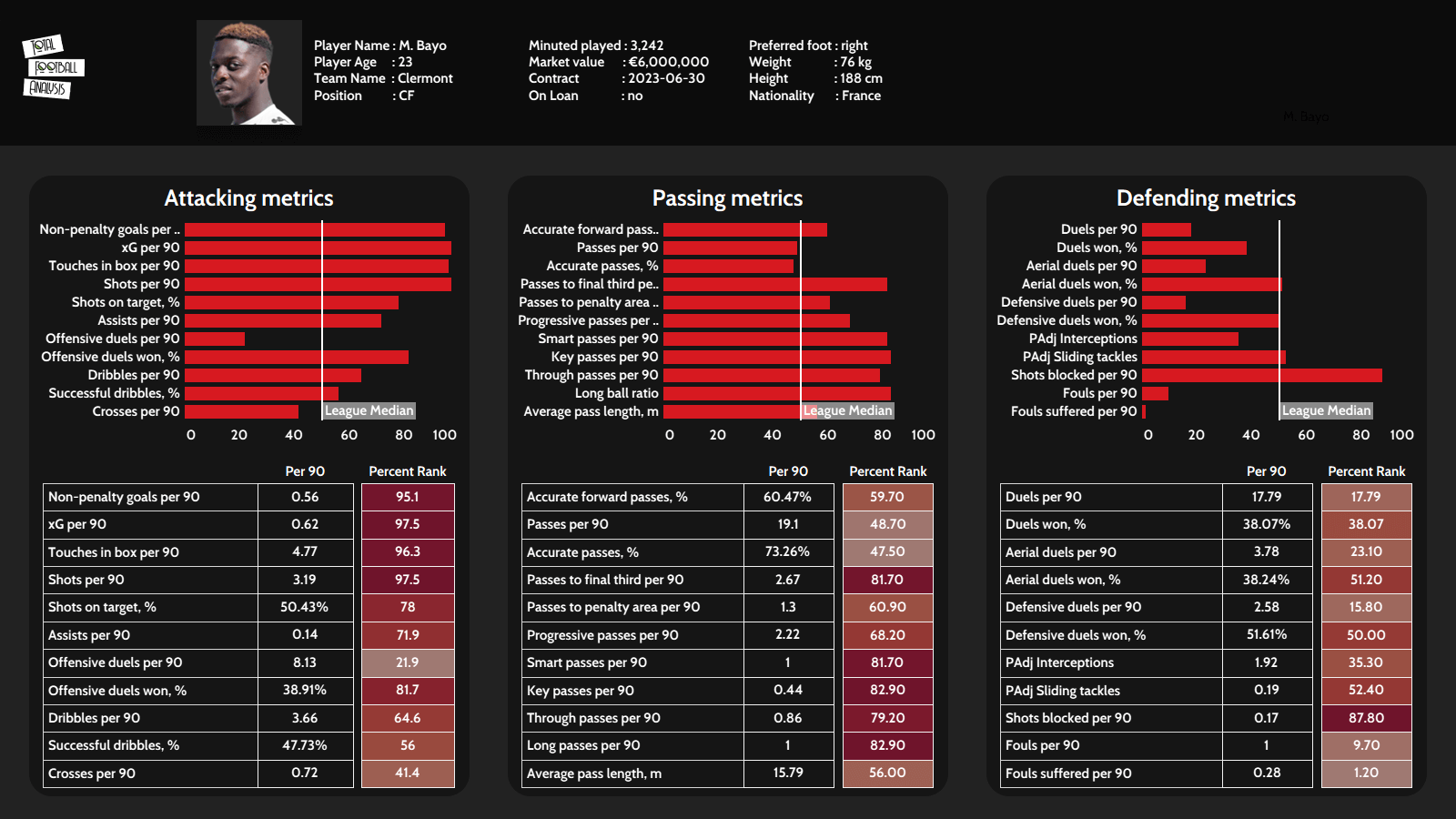
Mohamed Bayo is a French-born Guinean striker born in 1998. Product of Clermont’s youth system, he has played with them in the Ligue 2 (43 games and 22 goals, all of them in the last season) and on loan at USL Dunkerque in the French third division (14 goals in 34 games). After gaining promotion to the Ligue 1 last season and his first cap for Guinea, he’s ready for the next level.
Bayo is tall (188cm), athletic and has a great pace to run into space thanks to his long legs. His average in the air winning 38.07% of his aerials and strong to shield the ball from rivals as shown by his 38.91% success rate in offensive duels (82nd percentile).
On the ball, Bayo is technically just ok and does better when he plays in few touches. When he has space in front of him, he uses his pace to get past defenders. He’s above average in dribbling, both in quantity and quality, completing 47.73% of the 3.66 dribbles he attempts per 90.
A useful player in the buildup, Bayo offers passing lanes with his back to the goal and is intelligent and calm when he receives the ball, looking to progress with passes to the wings before returning to his position upfront. He can also combine in the second line and put his teammates into play with nice layoffs. Playing for a dominant team at a lower level, he stands out in most passing stats, showing promising signs but being a gamble still.
When his team has already progressed, he makes good runs in behind to force the defensive line back and create space. Once in the attacking third, he finds space between the centre-backs and uses his size to head crosses and also his pace and strength to anticipate and protect the positions he wins.
In transitions, once he’s ahead of the defender he’s almost impossible to catch and gets into good positions to receive the ball and score. Bayo is also very dangerous running in behind, he’s difficult to stop once he starts running and can create distance from the defenders even when he starts his runs from deeper positions.
Despite his great scoring record, Bayo isn’t a great finisher. He usually manages to get his shots on target but hasn’t shown real quality in front of the goal and has underperformed his xG by 0.06 goals per 90. He’s better when he can finish in just one touch. When he has to create space to shoot or has a lot of time he’s not consistent and you can see he lacks some technique and composure. His shot selection is also improvable as lots of his attempts hit the defender’s legs. On the positive side, he uses both feet to finish and has had some quality goals so it’s more about his consistency.
Bayo is still raw and unproven at the highest level but has excellent physical conditions and has scored more and more goals as he has played in better leagues. Taking him directly to the EPL would be a very risky move but it could pay off if his adaptation is quick and Southampton can get the best out of him.
Alexander Schmidt – 23, LASK Linz (on loan at St. Pölten last season), Austrian Bundesliga
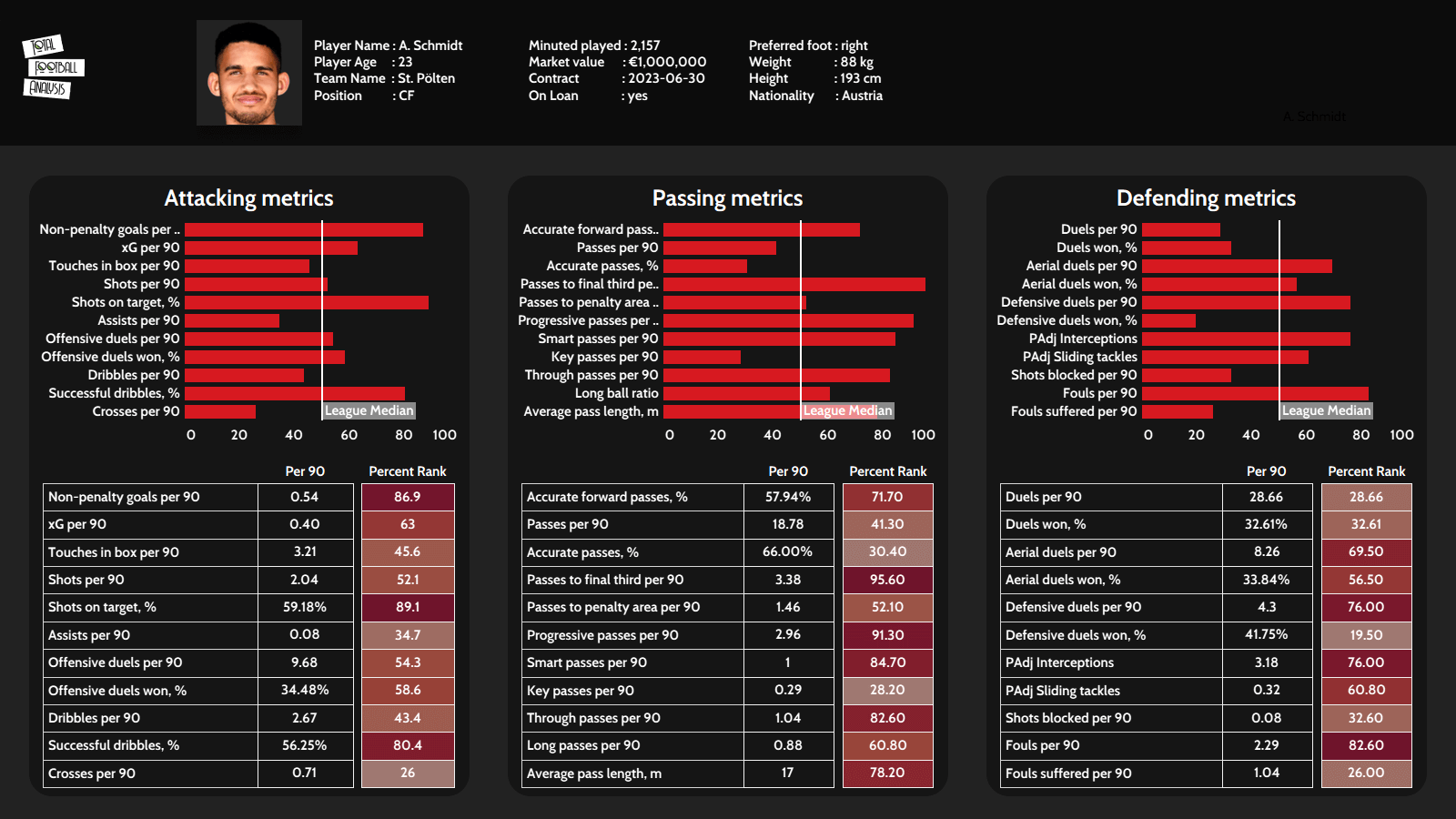
Alexander Schmidt is a 1998-born Austrian striker who plays for LASK Linz in the Austrian Bundesliga. He came through the academy at RB Salzburg, playing for Liefering (their B team), where he scored eight goals in 36 games in the 2.Bundesliga. After an unsuccessful loan to the first division with Wolfsberger in which he failed to score in 25 games, LASK Linz bought him and loaned him to St. Pölten last summer. His loan was very successful, scoring 13 goals in 32 games and earning the opportunity to play for his club. He’s currently part of the U21 Austrian national team.
Standing at 193cm, Schmidt is a powerful and strong striker who is also fast with spaces. He can get past players easily in transitions using his long legs to create separation and his body to shield the ball. He also works very hard and is above-average in several defensive metrics so he would fit into Southampton’s pressing tactics.
Good at receiving with his back to the goal, Schmidt is a good option to progress from the back. Once he has the ball, he shows excellent quality in his passing, often getting the ball into the final third with progressive and through passes to run into the box from the second line afterwards. With players running past him and into space, he can create chances and help his team get into the final third.
As proof of his top passing ability, Schmidt ranks in the top 20% of strikers in the Austrian Bundesliga in the following metrics: passes to final third (3.38 per 90), progressive passes (2.96 per 90), smart passes (1 per 90) and through passes (1.04 per 90).
Schmidt is great at combining before running in behind to receive the ball back and shoot. He can do this with his back to the goal, playing great layoffs, turning and attacking space, or running with the ball towards the goal and getting past the last defender with a quick one-two. For a player of his size, it’s a great asset to be able to do this and intervene in the second line.
When approaching the goal, Schmidt times his runs well to move in behind when his team is around the final third, offering options for a killer pass. His first meters are quick and defenders often don’t have time to react and catch him once he starts his movement.
In the box, he mostly tries to anticipate the centre-backs and attack the near post, using his physicality to protect his position and create space to receive and finish.
Two-footed when finishing. Schmidt usually goes for accuracy over power but can also combine both in shots from middle range. He’s an excellent finisher, having outperformed his xG by 35% (0.54 goals from 0.4 xG per 90). He’s also capable of more creative ways of finishing like dribbling the goalkeeper.
There are a couple of areas of improvement in his finishing though. First, sometimes he prefers to control the ball instead of taking a first-touch shot, which increases his effectiveness in front of the goal but also makes him lose some chances. Second, he uses his size and power very well to win aerials in the box but his heading isn’t accurate and misses some very good chances.
Conclusion
Any of these strikers would of course be a risky gamble to replace a proven goalscorer like Danny Ings. However, our data suggests they’re all similar to the new Aston Villa player and they could represent interesting options for Southampton to have in mind in case they don’t want to spend big on their next striker.





Comments